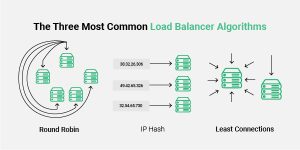Contents
Load Balancing Benefits: Optimizing Performance and Scalability for Your Website
Load balancing benefits include improved performance and scalability for your website. By distributing network traffic efficiently and handling high traffic volumes, load balancers ensure optimal resource utilization. They also provide high availability and redundancy, ensuring uninterrupted service. Different types of load balancers, such as application load balancers and hardware load balancers, offer flexibility in implementation. Load balancing algorithms like round robin and least connection method further enhance the distribution of traffic. Implementing load balancers, whether in the cloud or with specific software, offers capabilities for DevOps and efficient management of TCP and UDP traffic, including SSL offloading and session persistence.
There are several load balancer benefits:
- Flexibility: Load balancers offer the freedom to modify and customize the load balancing algorithm, configuration, and adapt to evolving requirements.
- Scalability: With load balancers, organizations can easily scale their infrastructure by adding or removing servers as needed. With load balancers, websites can efficiently handle increasing traffic demands, ensuring a seamless user experience even during peak periods.
- Cost-effectiveness: Load balancers eliminate licensing fees, reducing overall infrastructure costs.
- Community support: Load balancers benefit from a vibrant community of developers and users who contribute to their development, offer support, and share best practices.
Ensuring High Availability and Redundancy
Another critical benefit of load balancers is their ability to ensure high availability and redundancy. By distributing traffic across multiple servers or data centers, load balancers provide fault tolerance, reducing the risk of a single point of failure. In the event of a server or data center failure, load balancers automatically redirect traffic to available resources, ensuring uninterrupted service for website visitors. This redundancy also enhances overall system resilience and minimizes the impact of any potential hardware or software failures.
Load Balancer Types and their Features
Network Load Balancer
Network load balancers distribute traffic across multiple servers at the network level, leveraging techniques such as round-robin or least connections. They are ideal for handling high volumes of traffic and are commonly used in scenarios where session persistence is not required.
Application Load Balancer
Application load balancers operate at the application layer and are capable of analyzing the content of incoming requests to intelligently distribute traffic based on specific criteria, such as URL paths or headers. They provide advanced features like SSL/TLS termination, content-based routing, and session persistence, making them suitable for complex applications and microservices architectures.
Software Load Balancer
Software load balancers, also known as software-based or application-based load balancers, are implemented as software solutions running on virtual machines or containers. They offer flexibility and scalability by allowing organizations to leverage their existing infrastructure and easily scale horizontally. SKUDONET provides a powerful software load balancer with extensive configuration options.
Each type of load balancer offers unique features and benefits, and the specific requirements of your applications will determine the most suitable choice. By understanding the strengths and use cases of network load balancers, application load balancers, and software load balancers, you can make an informed decision to optimize the performance and availability of your services.
Load Balancer Algorithms and Techniques

Load balancer algorithms and techniques play a crucial role in distributing traffic efficiently across servers. They ensure optimal resource utilization, improved performance, and scalability. This section explores two popular load balancing algorithms: Round Robin and Least Connections, and provides insights into choosing the right algorithm for your application.
Round Robin
The Round Robin algorithm evenly distributes incoming requests among available servers in a cyclic manner. It assigns each request to the next server in line, ensuring a fair distribution of the workload. Round Robin is simple to implement and works well when servers have similar capabilities. However, it may not take server load or performance into account.
Least Connections
The Least Connections algorithm directs requests to servers with the fewest active connections. It ensures that servers with the lightest workload receive new requests, effectively balancing the traffic. This algorithm is beneficial for applications with varying server capabilities or when requests have different resource requirements. However, it may not consider server performance or utilization.
Choosing the Right Algorithm for Your Application
When selecting a load balancing algorithm, consider factors such as server capabilities, traffic patterns, and desired outcomes. Round Robin is suitable for evenly distributing load among servers, while Least Connections is ideal for optimizing resource allocation. For more advanced scenarios, other algorithms like IP Hash, Weighted Round Robin, or Least Response Time can be considered. Ultimately, the right algorithm depends on your application’s specific needs and objectives.
As technology continues to evolve, load balancers have become a fundamental component of any successful website infrastructure. Understanding their benefits and leveraging their capabilities can significantly improve website performance, scalability, and availability, ultimately leading to increased user satisfaction and business success.
SKUDONET: Your Next-Level Load Balancer Solution!
SKUDONET it’s a game-changer for your IT infrastructure. As a cutting-edge load balancing solutions, SKUDONET goes beyond the basics, offering a host of features to optimize your system’s performance, enhance scalability, and streamline operations.
Try SKUDONET Now!
We invite you to explore SKUDONET and experience the power of our open source load balancer.
Try a fully functional Enterprise version of SKUDONET for 30 days and you will have an engineer dedicated to your project to answer your questions and help you with the initial configuration. You can also download the Community Free Open Source Balancer edition to discover the full potential it can offer you.
Thank you for being part of the SKUDONET journey – where excellence meets accessibility!


